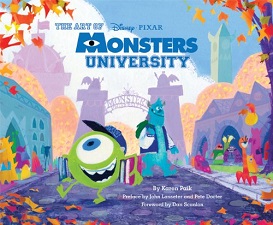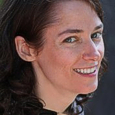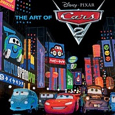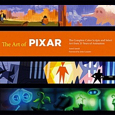 With Monsters, Inc. in 2001, Pixar Animation Studios introduced audiences to the #1 scaring team, Mike and Sulley, and the monstrous world behind the closet doors of our bedrooms. In this prequel to the much-loved classic, Mike and Sulley meet at Monsters University, where they are joined by a few familiar faces and a host of delightful new characters while trying to earn degrees in scaring.
With Monsters, Inc. in 2001, Pixar Animation Studios introduced audiences to the #1 scaring team, Mike and Sulley, and the monstrous world behind the closet doors of our bedrooms. In this prequel to the much-loved classic, Mike and Sulley meet at Monsters University, where they are joined by a few familiar faces and a host of delightful new characters while trying to earn degrees in scaring.
Karen Paik takes readers behind-the-scenes of this world in The Art of Monsters University, having interviewed the film’s many artists for the ultimate inside look at the conception and production of Pixar’s latest blockbuster. Featuring character sculpts, color scripts, storyboards and more, The Art Of Monsters University explores the process of creating this new and expanded Monster universe.
Paik also wrote To Infinity And Beyond!: The Story Of Pixar Animation Studios and The Art Of Ratatouille, and co-authored The Art Of Cars 2. When she isn’t writing about Pixar’s features, Paik helps make them in the studio’s development department. Animated Views is thrilled to speak with Paik about her exciting role at Pixar and The Art Of Monsters University!
Animated Views: Would you explain your role in the development department at Pixar and, more specifically, in the development of Monsters University? What makes your job fun?
Karen Paik: I wasn’t as involved in the early days of Monsters University as I have been in some other projects that have come through development — for which I’ve done a mix of things including research, reading scripts to evaluate potential writers, pitch preparation, and story feedback — but I did attend one of the early story off-sites for the project. For me, what makes the early days of a new project unique is the exhilarating sense of potential. Ed Catmull once compared working in the early days of computer graphics to being one of the first people to an Easter egg hunt, and I think there’s a similar sense of excitement to being around a new story.
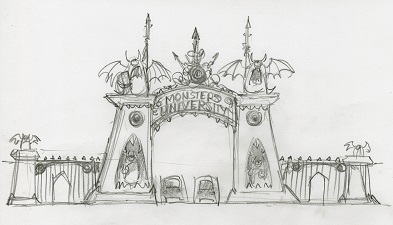
AV: You wrote some important Pixar books. How did you come to the writing field?
KP: It started with To Infinity And Beyond! The project was in progress when Ed asked for my take on it — I shared some of my thoughts with him and, soon afterward, ended up writing it. That then led to me being involved with the Art Of books. My experience at the studio definitely helps with the writing, since I know many of the people working on the films and, in most cases, have been watching the project grow and evolve for years.
AV: For The Art Of Monsters University, how did you collaborate with the sources of your information?
KP: Just about every piece of art done for a film is scanned into a massive database not long after it is created. So, when it comes time to collect the art for the book, everything is pretty much at one’s fingertips. The production designer oversees the selection of work from the art department, and the story supervisor does the same for the story department. The director provides important input on the project at every stage. But it’s generally the production designer who communicates most directly with the book’s designer on the look of the book and specifics of execution.
My job is to talk with the filmmakers and try to figure out the best way to integrate the story of the film’s creation with the art that will appear in the book. I generally try to do this using the direct voices of the artists wherever possible — who could be better suited to explaining why certain choices were made than the artists themselves?
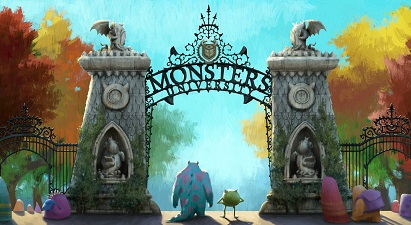
AV: All Pixar artists have intriguing personalities. Would you recall one or two of the most memorable interviews you had for this book?
KP: The conversation with the director is always an incredibly important one, of course, because they are the one whose decisions are driving and shaping the project on the most fundamental level. In addition to talking about the goals of the film, Dan Scanlon spoke very sincerely and memorably about his appreciation for the crew, and talked in considerable detail about how their work inspired him and helped refine his thinking.
It was also a lot of fun to talk to the Monsters University filmmakers who were veterans of the first film, and to get their perspective on the similarities and differences between the projects. Ricky Nierva, M.U.‘s production designer, worked on the original designs for Mike and Sulley, so it was great to get his take on coming up with younger versions of the characters. Kori Rae, M.U.‘s producer, was the production manager and associate producer on Monsters, Inc., so it was fascinating to hear her talk about the production of this new film given her familiarity with the first one. The crew had a great mix of people who were veterans of the Monsters world and people who were new to the Monsters world, and I think that ended up being really beneficial for the film.

AV: Your book says that, in Monsters University, college is a character in itself. Can you explain how the Pixar artists realized that?
KP: I think it’s a handy way of conceptualizing the relationship between the characters and their environment. Thinking of college as another character helps remind you that there should be a connection, a back-and-forth between the characters in the story and the world they inhabit. If a story doesn’t feel rooted in and influenced by its environment, it won’t be believable.
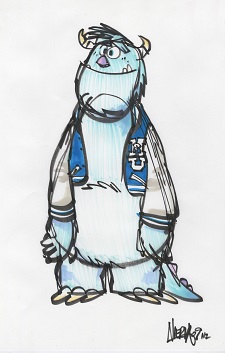
AV: When people think of a typical university, they expect certain things. By contrast, what surprised you about the Pixar artists’ treatment of that environment?
KP: Well, I think the biggest difference in the way the filmmakers approached the subject matter was in seeking to make a film that would resonate with a broad audience, not just the rather specific subset of the population that “college films” often target. So, for all the classic college elements that they reference — fraternities and sororities, the intimidating professor, the final exam — in each case, they’re seeking to connect to the spirit of that element — disparate social groups, the gatekeeper figure, the test of ability — rather than the letter of it.

AV: In the book, you explain how Monsters University shows more of the monster world. What part of that world was, to you, the most interesting?
KP: I love the moment when you see the aquatic monsters swimming into their underwater building. It’s a delightful moment in and of itself, and also a great little connection to the first film — if you look at the original Monstropolis concept art created for Monsters, Inc., you can see that one of the initial ideas was to make it a city of canals.
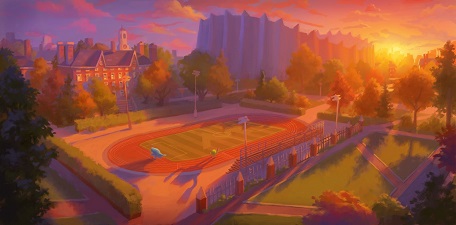
AV: You quote the extraordinary Dice Tsutsumi, saying that they wanted to combine the palette of the first film with the latest rendering tricks. Would you explain that unique blending of visual styles and techniques in Monsters University?
KP: I couldn’t presume to speak to the details of Dice’s assessment of, and approach to, this subject. But my — much simpler — layperson’s understanding is that he wanted this film to take advantage of all the subtlety and fine control now achievable with CG, while simultaneously holding onto the stylized visual characteristics of the first film, especially the intensely saturated colors and sharp lighting contrasts.

AV: One of the other innovations of Monsters University was the Global Illumination software presented by Jean-Claude Kalache. Can you tell us about it ?
KP: As I understand it, Global Illumination allows the film’s lighters to work with “virtual light” that now behaves much more like light does in the real world. This virtual light can automatically create more realistic shadows with subtle variations, reflect off of multiple surfaces, or reflect colors from one surface to another. Getting more of this realistic behavior “for free” consequently allows the lighters to spend more of their time on creating lighting that is maximally dramatically appropriate.

AV: Your first book, To Infinity And Beyond!, goes from the beginning of the company to Ratatouille. Can we hope for a sequel?
KP: I’m sure the story will be continued one day, but it would need to be when the time is right. Sometimes it’s only with the perspective that time gives you that you can see where the next natural break in the story lies. To Infinity And Beyond! covered well over two decades’ worth of Pixar’s history — and it’s only been seven years since then!
Our thanks to Karen Paik, April Whitney and Krissy Bailey!



